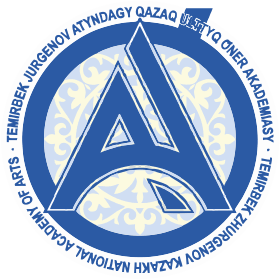- Бакалавриат:
- +7(727)-272-46-74
- Магистратура: 8 (727) 272-43-98
Kylkobyz
Zhetygen
25.06.2020Sybyzgy
25.06.2020Kylkobyz
FACULTY “MUSICAL ART”
TRADITIONAL MUSICAL ART
Applicants applying for the “Traditional Musical Art” educational program (Folk Instruments – Kylkobyz) must have a document of a standard form about secondary special musical education. The applicant must demonstrate a sufficient level of performing and musical-theoretical training, which is checked on creative exams:
1) Performing arts,
2) Theory of music. Solfeggio. Harmony.
At the performing arts exam, the entrant performs a solo program, where the degree of complexity of the program and the artistic and technical perfection of the performance are evaluated. The exam on theory, solfeggio and harmony assesses musical and theoretical knowledge – intonation of gamut and intervals with resolution in the keynote, solfeggio of a single-voice number, and harmonic analysis of an excerpt from the musical piece.
Creative examinations:
Creative examinations:
1.Performance art.
– Lyrical composition.
– Kui demonstrating masterly mastery.
THE THEORY OF MUSIC. SOLFEGGIO. HARMONY.
(ORAL, TICKET RESPONSES)
Sample ticket:
- Perform in a certain tonality: two types of gamma, characteristic intervals and tritons with resolution. Solfege a single-voice example (Solfeggio 1 part B. Kalmykov and G. Fridkin. – M.: “Music”, № 620 p. 126)
- Make a harmonic analysis of an excerpt from a musical composition. (A. Nuralieva. Atkenshek (7 pages) / / Album of piano pieces. Comp.Baisakalova A. B.-Almaty: “Tulpar”, 2009)
- Answer the question on music theory:
Themes
- General classification of intervals
- General classification of chords
- Cadence, period, sentence
- The dominant seventh chord occurs, its treatment, resolution to the tonic
- Introductory seventh chords, his conversion, resolution to the tonic
- Seventh chords of the second stage, his conversion, resolution to the tonic
- Diatonic and chromatic tones and semitones
- What does mean the term deviation in music?
- What does mean the term modulation?
- Octave names and letter designations.
- Enharmonically equal intervals.
- Tonality. The quint circle of tonalities.
- Types of triads.
- Seventh chord. Types of seventh chords.
- Newts and characteristic intervals.
- Chromaticism and alterations.Chromatic gamma.
- Frets of folk music.
- Simple intervals.
- Composite intervals.
- Music system.Notation. Keys.
- Musical syntax.
- The melismas.Types of melismas.
- General classification.
- Types of sequences.
- Types of transposition.
- Rhythm. Tempoes.
- Size.
- Fret classification.
- Anharmonism of sounds, intervals, chords, tonalities.
FACULTY “MUSICAL ART”
TRADITIONAL MUSICAL ART
Applicants applying for the “Traditional Musical Art” educational program (Folk Instruments – Kylkobyz) must have a document of a standard form about secondary special musical education. The applicant must demonstrate a sufficient level of performing and musical-theoretical training, which is checked on creative exams:
1) Performing arts,
2) Theory of music. Solfeggio. Harmony.
At the performing arts exam, the entrant performs a solo program, where the degree of complexity of the program and the artistic and technical perfection of the performance are evaluated. The exam on theory, solfeggio and harmony assesses musical and theoretical knowledge – intonation of gamut and intervals with resolution in the keynote, solfeggio of a single-voice number, and harmonic analysis of an excerpt from the musical piece.
Creative examinations:
Creative examinations:
1.Performance art.
– Lyrical composition.
– Kui demonstrating masterly mastery.
THE THEORY OF MUSIC. SOLFEGGIO. HARMONY.
(ORAL, TICKET RESPONSES)
Sample ticket:
- Perform in a certain tonality: two types of gamma, characteristic intervals and tritons with resolution. Solfege a single-voice example (Solfeggio 1 part B. Kalmykov and G. Fridkin. – M.: “Music”, № 620 p. 126)
- Make a harmonic analysis of an excerpt from a musical composition. (A. Nuralieva. Atkenshek (7 pages) / / Album of piano pieces. Comp.Baisakalova A. B.-Almaty: “Tulpar”, 2009)
- Answer the question on music theory:
Themes
- General classification of intervals
- General classification of chords
- Cadence, period, sentence
- The dominant seventh chord occurs, its treatment, resolution to the tonic
- Introductory seventh chords, his conversion, resolution to the tonic
- Seventh chords of the second stage, his conversion, resolution to the tonic
- Diatonic and chromatic tones and semitones
- What does mean the term deviation in music?
- What does mean the term modulation?
- Octave names and letter designations.
- Enharmonically equal intervals.
- Tonality. The quint circle of tonalities.
- Types of triads.
- Seventh chord. Types of seventh chords.
- Newts and characteristic intervals.
- Chromaticism and alterations.Chromatic gamma.
- Frets of folk music.
- Simple intervals.
- Composite intervals.
- Music system.Notation. Keys.
- Musical syntax.
- The melismas.Types of melismas.
- General classification.
- Types of sequences.
- Types of transposition.
- Rhythm. Tempoes.
- Size.
- Fret classification.
- Anharmonism of sounds, intervals, chords, tonalities.
